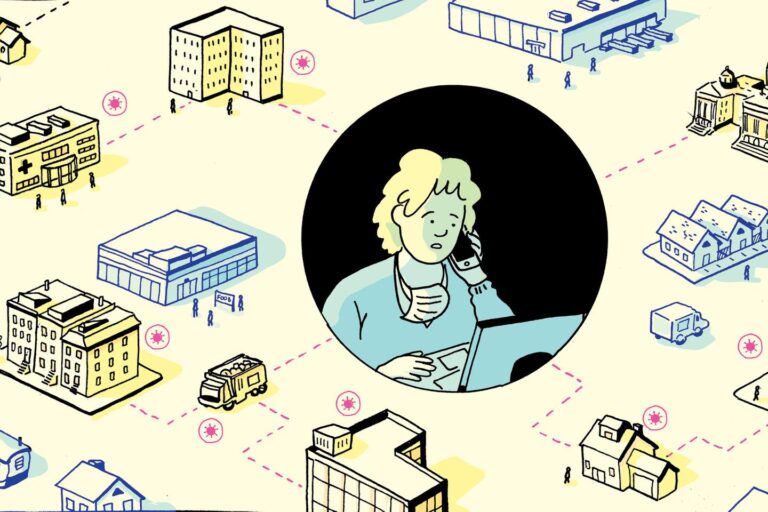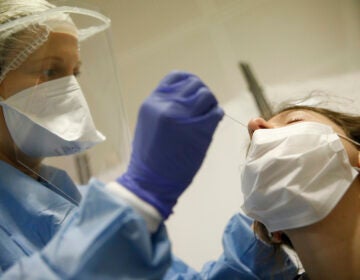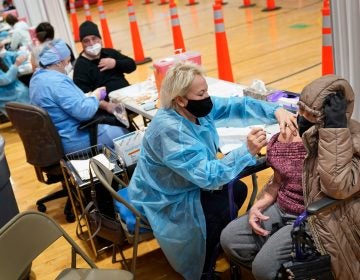Parts of Pa. reopened without robust coronavirus contact tracing to keep residents safe
Health experts say the shortcoming is of critical concern because tracing is most needed as reopening begins, when the disease’s spread becomes more complex.

(Dan Nott for Spotlight PA)
Spotlight PA is an independent, nonpartisan newsroom powered by The Philadelphia Inquirer in partnership with the Pittsburgh Post-Gazette and PennLive/Patriot-News. Sign up for our free weekly newsletter.
Three months after the coronavirus first struck Pennsylvania, signs of normalcy are returning: People are heading back to work, dining in at restaurants, and getting long-awaited haircuts. Day cares are open and schools will soon follow.
But behind these signs of hope lurks the possibility of a resurgence. With no treatment for the coronavirus and a vaccine still months — if not years — away, public health experts say there is only one way to maintain this progress and prevent another society-wide shutdown:
Timely and robust contact tracing.
In fact, Gov. Tom Wolf and Health Secretary Rachel Levine have repeatedly stated that strong contact tracing systems — the ability to locate infected individuals, identify their close contacts, and ask those contacts to quarantine — are a critical prerequisite to reopening.
But amid mounting pressure from lawmakers and residents to resume normal operations, Wolf has moved a majority of the state’s counties to the least restrictive green phase of reopening without a full and consistent contact tracing system in place.
At the moment, a patchwork of hospital systems, nonprofits, county governments, and state-employed public health nurses is tackling the work — leaving some regions flush with resources, and others with limited tracing and at greater risk for future outbreaks.
“The most urgent time for contact tracing is when you’re opening up,” said Edward Salsberg, a senior researcher at George Washington University’s Institute for Health Workforce Equity, where he helped build a tool to estimate the number of tracers needed in different states. “You want to give people some confidence that it’s going to be relatively safe out there to go back to a normal routine.”
Yet in Pennsylvania, it’s difficult to assess the safety of reopening because there is no centralized contact tracing system. The Wolf administration is working to corral disparate efforts into six regional consortiums, but so far only one has been announced, in the southwest, and it’s in early stages.
There also has been no public movement on a program Wolf announced in May to train residents unemployed by the pandemic to help with the state’s contact tracing needs.
In the meantime, a reopening scorecard issued by the administration gives counties credit for contact tracing whether it’s being done or simply “being implemented,” with no clear definition of what that means.
“I would prefer to have this infrastructure in place as we go to green,” said Rep. Dan Frankel, the Democratic chair of the House Health Committee, “but that’s a decision the Department of Health has decided to go ahead with.”
“It strikes me that we’re still not at the point where we have the staffing or infrastructure necessary to do this on a broad scale,” he added. “There needs to be a much more organized and coordinated approach to contact tracing.”
The Wolf administration said contact tracing is occurring in all regions. About 130 Health Department employees are involved, with additional volunteers and county-level employees across the state.
“We intend to double our contact tracers in the near future and know that we may need to further increase that number as we move forward,” the administration said in a statement.
Levine, the health secretary, has said an “aspirational goal” is to have thousands of contact tracers across the state by late summer or early fall, but has not committed to a specific number. Public health experts estimate Pennsylvania needs from 2,000 to 4,000 tracers — right now.
As reopening progresses and people have more contacts, each positive case could require twice as many calls, Salsberg said.
Erie County — among the first counties to move to the “yellow” phase of reopening, which lifts the stay-at-home order and allows retail businesses to resume in-person operations — has already seen this.
“In the red phase we would rarely see anyone with 10 contacts,” said county Public Health Director Melissa Lyon. “When we went to yellow, we saw an increase: 10, 20, and even as high as 30 contacts in some cases.”
Levine said, as of early June, state epidemiologists were concerned they were seeing another outbreak there. The county currently has 18 employees working on contact tracing efforts but is in the process of hiring another 18, Lyon said, as it anticipates an increase in the number and complexity of cases with more parts of the state moving to less restrictive phases.
Across the nation, local governments have been taking a variety of approaches to increase contact tracing workforces as they reopen. Massachusetts contracted with a local nonprofit to hire nearly 1,700 tracers. San Francisco is training librarians, and a county in Maryland is asking school nurses to help. Many states are calling on the medical reserve corps, as well as college students and public volunteers, said Lori Tremmel Freeman, CEO of the National Association of County and City Health Officials.
The bottom line, experts said, is the ability to reach all the contacts of a newly positive individual within 24 hours. Otherwise, people won’t know they’ve been exposed to the virus and will continue going out and potentially spreading it to others.
“If you can’t do that, you probably need more tracers,” Salsberg said.
The state’s emerging partnerships
When the coronavirus first arrived in Pennsylvania, the state’s roughly 130 public health nurses led the charge on contact tracing. But a Spotlight PA investigation found that decades of budget cuts and court battles had left only a skeleton workforce, and it was quickly overwhelmed by the deluge of coronavirus cases.
At the height of the pandemic, the nurses were forced to forgo calling contacts themselves and instead ask individuals who tested positive to pass on the information to others. But now, with numbers trending downward, they are resuming calls to contacts.
In late April, the Health Department launched a contact tracing work group tasked with building a statewide strategy to supplement the nurses’ efforts. The administration declined interview requests but said in a statement that the group is creating six regional partnerships, which include public health staff, health providers, academic institutions, and community organizations, to coordinate contact tracing work. The state has $3.5 million in federal funds for this purpose.
The first regional consortium, in Southwestern Pennsylvania, met on May 28. According to the Jewish Healthcare Foundation, which helped the state build the consortium, the group of nearly 50 organizations is still finalizing how many tracers are needed and how they will be funded. They will begin recruiting soon — even as all the counties in Southwestern Pennsylvania have already entered the green phase of reopening.
“The consortium is moving with an expedited process to do that type of work,” said Robert Ferguson, chief policy officer of the foundation.
Other regional collaboratives have yet to be announced.
The Lehigh Valley Health Network was mentioned in the state’s contact tracing plan released in May, as a partner in the northeast.
For several months, the hospital system has been conducting its own contact tracing for patients who get a positive COVID-19 test in their facilities, said chief integration officer Robert X. Murphy Jr. And it has worked with local health departments in Bethlehem and Allentown to reduce duplicate efforts. But the state has not yet asked the hospital system to expand contact tracing efforts outside of its health network, Murphy said.
Another aspect of the regional consortiums involves student volunteers. Levine said the Temple University College of Public Health is set to train 200 students as contact tracers for southeast and northeast Pennsylvania by mid-June.
In the central part of the state, medical students from the Pennsylvania State University College of Medicine have been tracing the contacts of anyone who tests positive through Penn State health facilities since late March.
Additionally, 40 Penn State public health science students have been working with the state’s public health nurses to do contact tracing across the south-central region since May, said Ping Du, an associate professor of medicine and public health sciences. The students are trained and supervised by state health officials and will continue volunteering as long as needed, Du said.
“In case there’s an increase in COVID-19 cases, we’re ready to respond,” she said. “If we don’t do contact tracing in a timely manner, eventually we won’t be able to control the disease.”
Counties taking the lead
In many counties, local leaders are implementing their own contact tracing plans rather than waiting for the state.
Lancaster County entered a $25 million contract with Penn Medicine Lancaster General Health to oversee testing and contact tracing services, beginning in late May. The project currently has about 40 tracers, who work in partnership with the state’s public health nurses, said Michael Ripchinski, the hospital’s chief clinical officer.
State nurses call patients who test positive in Lancaster County, ask about their recent contacts, and then pass along that list of contacts to the Lancaster General team.
When the county was under a stay-at-home order, that list was typically four people or fewer, Ripchinski said. But he expects the number to increase now that the county has moved to the yellow phase. The team is interviewing members of the public for up to 100 more positions based on need.
Berks and Montgomery Counties — both of which have been especially hard hit by the pandemic — opted to contract with local nonprofits, hoping that would increase community trust at a time when many are wary of contact tracing.
“We have to get this contact tracing done — that’s how we keep a lid on this virus,” said Val Arkoosh, chair of the Montgomery County Board of Commissioners. “But if people don’t feel safe sharing this information, we’re doing it with one hand tied behind our back.”
Contact tracing, while entirely confidential, relies on people voluntarily sharing information about where they’ve been and whom they’ve interacted with. As such, nonprofits that are known in the community might have more success asking people personal questions, she said. They can also help connect individuals to food banks, pharmacy delivery services, or other social services in order to make quarantining possible.
Arkoosh said the county has contracted with four local nonprofits to add 24 more tracers and supervisors to its current team of 20 county public health employees and medical reserve corps volunteers.
Berks County, on the other hand, does not have its own health department and has not had any county employees doing contact tracing. Instead, it entered into a $1 million contract with Co-County Wellness Services, a nonprofit that has long provided HIV and sexually transmitted infection services in the area. The organization will use 10 of its employees for contact tracing work, and add up to 50 more local residents in volunteer or part-time paid positions, said Carolyn Bazik, director of Co-County Wellness Services.
Before this contract, state public health nurses in the area were managing to call only positive cases but couldn’t get to any of their contacts, due to the workload, Bazik said.
Other counties, including Allegheny, Bucks, and Chester — all of which have their own health departments — are using a combination of county employees and volunteers to do contact tracing. (Chester County is also doing contact tracing for neighboring Delaware County, which doesn’t have its own health department.)
Philadelphia officials have about a dozen tracers working with long-term-care facilities and hospitals, but officials said widespread tracing won’t be manageable until the average case count drops significantly. As the numbers decrease, they will hire more contact tracers using federal grant money given directly to the county.
But for many counties across Pennsylvania, building their own contact tracing system isn’t feasible.
Luzerne County, which is among the top 10 counties by number of coronavirus cases, is relying on the state Health Department, said County Manager David Pedri. Just last week, state health officials informed county emergency management that they will be conducting tracing for individuals and congregate facilities, Pedri said, but did not provide details on how many individuals will be doing this work.
Several county emergency managers in Western Pennsylvania have complained about a lack of communication from the Department of Health regarding contact tracing. That’s concerning, said Frankel, the representative from Allegheny County, since many counties don’t have local health departments or hospital systems to fall back on.
“Ultimately the state Department of Health is going to be responsible for figuring out how to get contact tracing done in counties that don’t have any public health infrastructure,” he said.

Delays in recruiting residents to help
One option for regions without contact tracing infrastructure is to rely on local residents instead. In May, Wolf announced the Commonwealth Civilian Coronavirus Corps to do just that.
Reminiscent of the New Deal, the plan laid out a goal of recruiting and training Pennsylvanians who were unemployed due to the pandemic, and hiring them for public service contact tracing roles. But more than a month later, hiring has not begun.
Pennsylvania has been awarded a nearly $7 million grant from the U.S. Department of Labor to hire unemployed workers for pandemic response jobs. But the Wolf administration said multiple bureaucratic steps need to be taken before hiring can begin.
The civilian corps is meant to prepare for a possible fall resurgence of COVID-19, the administration told Spotlight PA. The delayed timeline has disappointed some residents who were eager to help the state while also earning a paycheck.
Deborah Lovelace was working at a grocery store in Bucks County earlier this year when she got sick and had to leave the position. When she heard about the civilian corps, she excitedly began her online registration. But she stopped midway through when it became clear the state was looking only for volunteers.
She wanted to help, she told Spotlight PA, but finding a paid position to pay the bills was her most pressing concern.
“If they were not going to pay, I had to find something that did, so I could have the basics of life,” Lovelace said.
The Wolf administration said nearly 700 individuals have started or completed their registration with the state’s ServPA system. About a dozen have been deployed to help with contact tracing in the northeast as of last week, and officials are in discussions about deploying others.
But even among those who want to volunteer, the slow pace is frustrating.
Diane Ward, a registered nurse and nursing instructor at St. Luke’s University Health Network in Bethlehem, volunteered to help with the COVID-19 response in New York, New Jersey, and Pennsylvania. After submitting her online application for all three states, she received calls from New York and New Jersey seeking more information, but from Pennsylvania, only an automated email confirming her registration.
“It was disappointing,” she said. “I’m willing to volunteer, so it can’t be a financial issue.”
Like many other Pennsylvanians, Ward said she’s tired of the widespread restrictions and wants to help her community safely return to normal — if only the state will call on her.
“Contact tracing is the only way I think we’re going to stay safe, besides a vaccine,” Ward said. “So let’s get this show on the road.”
Spotlight PA reporter Daniel Simmons-Ritchie contributed to this article.
 100% ESSENTIAL: Spotlight PA relies on funding from foundations and readers like you who are committed to accountability journalism that gets results. If you value this reporting, please give a gift today at spotlightpa.org/donate.
100% ESSENTIAL: Spotlight PA relies on funding from foundations and readers like you who are committed to accountability journalism that gets results. If you value this reporting, please give a gift today at spotlightpa.org/donate.

Get daily updates from WHYY News!
WHYY is your source for fact-based, in-depth journalism and information. As a nonprofit organization, we rely on financial support from readers like you. Please give today.




![CoronavirusPandemic_1024x512[1]](https://whyy.org/wp-content/uploads/2020/03/CoronavirusPandemic_1024x5121-300x150.jpg)


